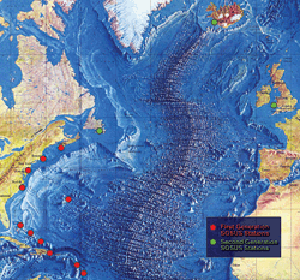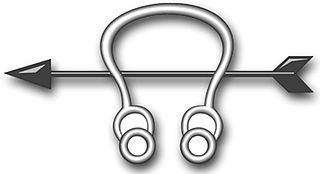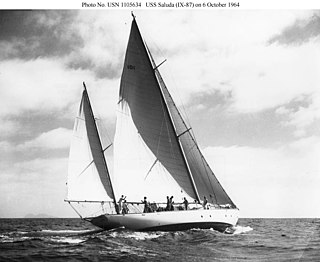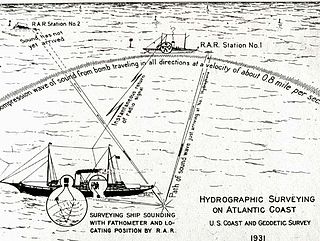Related Research Articles

Sonar is a technique that uses sound propagation to navigate, measure distances (ranging), communicate with or detect objects on or under the surface of the water, such as other vessels.

Echo sounding or depth sounding is the use of sonar for ranging, normally to determine the depth of water (bathymetry). It involves transmitting acoustic waves into water and recording the time interval between emission and return of a pulse; the resulting time of flight, along with knowledge of the speed of sound in water, allows determining the distance between sonar and target. This information is then typically used for navigation purposes or in order to obtain depths for charting purposes.

The Sound Surveillance System (SOSUS) was a submarine detection system based on passive sonar developed by the United States Navy to track Soviet submarines. The system's true nature was classified with the name and acronym SOSUS themselves classified. The unclassified name Project Caesar was used to cover the installation of the system and a cover story developed regarding the shore stations, identified only as a Naval Facility (NAVFAC), being for oceanographic research. In 1985, as the fixed bottom arrays were supplemented by the mobile Surveillance Towed Array Sensor System (SURTASS) and other new systems were coming on line, the name itself changed to Integrated Undersea Surveillance System (IUSS). The commands and personnel were covered by the "oceanographic" term until 1991 when the mission was declassified. As a result, the commands, Oceanographic System Atlantic and Oceanographic System Pacific became Undersea Surveillance Atlantic and Undersea Surveillance Pacific, and personnel were able to wear insignia reflecting the mission.

The SOFAR channel, or deep sound channel (DSC), is a horizontal layer of water in the ocean at which depth the speed of sound is at its minimum. The SOFAR channel acts as a waveguide for sound, and low frequency sound waves within the channel may travel thousands of miles before dissipating. An example was reception of coded signals generated by the Navy chartered ocean surveillance vessel Cory Chouest off Heard Island, located in the southern Indian Ocean, by hydrophones in portions of all five major ocean basins and as distant as the North Atlantic and North Pacific.

Anti-submarine warfare is a branch of underwater warfare that uses surface warships, aircraft, submarines, or other platforms, to find, track, and deter, damage, or destroy enemy submarines. Such operations are typically carried out to protect friendly shipping and coastal facilities from submarine attacks and to overcome blockades.
An underwater explosion is a chemical or nuclear explosion that occurs under the surface of a body of water. While useful in anti-ship and submarine warfare, underwater bombs are not as effective against coastal facilities.

A multibeam echosounder (MBES) is a type of sonar that is used to map the seabed. It emits acoustic waves in a fan shape beneath its transceiver. The time it takes for the sound waves to reflect off the seabed and return to the receiver is used to calculate the water depth. Unlike other sonars and echo sounders, MBES uses beamforming to extract directional information from the returning soundwaves, producing a swath of depth soundings from a single ping.

Sonar technician is a United States Navy occupational rating.

Underwater acoustics or hydroacoustics is the study of the propagation of sound in water and the interaction of the mechanical waves that constitute sound with the water, its contents and its boundaries. The water may be in the ocean, a lake, a river or a tank. Typical frequencies associated with underwater acoustics are between 10 Hz and 1 MHz. The propagation of sound in the ocean at frequencies lower than 10 Hz is usually not possible without penetrating deep into the seabed, whereas frequencies above 1 MHz are rarely used because they are absorbed very quickly.
Geophysical MASINT is a branch of Measurement and Signature Intelligence (MASINT) that involves phenomena transmitted through the earth and manmade structures including emitted or reflected sounds, pressure waves, vibrations, and magnetic field or ionosphere disturbances.
The University of California Division of War Research (UCDWR) was created at Scripps Institution of Oceanography at the University of California, San Diego campus during World War II to aid the U.S. Navy in war-related research.

USS Hunting (E-AG-398) was built as the LSM-1-class landing ship medium LSM-398 at the Charleston Navy Yard and launched in the first week of 1945. After service in the Atlantic as a landing ship the vessel was converted in 1953 to a sonar research vessel for the Naval Research Laboratory. Hunting was unique among Navy research vessels of the time in having a center well through which large towed "fish" could be transported and lowered to operating depths. The work contributed to sonar improvements and understanding ocean acoustics.

The interactions between marine mammals and sonar have been a subject of debate since the invention of the technology.
RAFOS floats are submersible devices used to map ocean currents well below the surface. They drift with these deep currents and listen for acoustic "pongs" emitted at designated times from multiple moored sound sources. By analyzing the time required for each pong to reach a float, researchers can pinpoint its position by triangulation. The floats are able to detect the pongs at ranges of hundreds of kilometers because they generally target a range of depths known as the SOFAR channel, which acts as a waveguide for sound. The name "RAFOS" derives from the earlier SOFAR floats, which emitted sounds that moored receivers picked up, allowing real-time underwater tracking. When the transmit and receive roles were reversed, so was the name: RAFOS is SOFAR spelled backward. Listening for sound requires far less energy than transmitting it, so RAFOS floats are cheaper and longer lasting than their predecessors, but they do not provide information in real-time: instead they store it on board, and upon completing their mission, drop a weight, rise to the surface, and transmit the data to shore by satellite.

USS Saluda (IX-87) was a wooden-hulled, yawl-rigged yacht of the United States Navy.

Captain Nicholas Hunter Heck was a career officer of the United States Coast and Geodetic Survey Corps. A leading geophysicist of his time, Heck made important contributions in the study of seismology and oceanography. He also revolutionized hydrographic surveying by developing the wire-drag surveying technique and introduced radio acoustic ranging into Coast and Geodetic Survey hydrography.

Radio acoustic ranging, occasionally written as "radio-acoustic ranging" and sometimes abbreviated RAR, was a method for determining a ship's precise location at sea by detonating an explosive charge underwater near the ship, detecting the arrival of the underwater sound waves at remote locations, and radioing the time of arrival of the sound waves at the remote stations to the ship, allowing the ship's crew to use true range multilateration to determine the ship's position. Developed by the United States Coast and Geodetic Survey in 1923 and 1924 for use in accurately fixing the position of survey ships during hydrographic survey operations, it was the first navigation technique in human history other than dead reckoning that did not require visual observation of a landmark, marker, light, or celestial body, and the first non-visual means to provide precise positions. First employed operationally in 1924, radio acoustic ranging remained in use until 1944, when new radio navigation techniques developed during World War II rendered it obsolete.

Naval Facility Point Sur was one of 30 secret sites worldwide that were built during the Cold War to detect Soviet submarines. In 1958, the U.S. Navy built a Naval Facility (NAVFAC) ½ mile south of Point Sur on the Big Sur coast to provide submarine surveillance using the classified SOund SUrveillance System (SOSUS). The public was told the station was engaged in oceanographic research.
Two closely related terms, Low Frequency Analyzer and Recorder and Low Frequency Analysis and Recording bearing the acronym LOFAR, deal with the equipment and process respectively for presenting a visual spectrum representation of low frequency sounds in a time–frequency analysis. The process was originally applied to fixed surveillance passive antisubmarine sonar systems and later to sonobuoy and other systems. Originally the analysis was electromechanical and the display was produced on electrostatic recording paper, a Lofargram, with stronger frequencies presented as lines against background noise. The analysis migrated to digital and both analysis and display were digital after a major system consolidation into centralized processing centers during the 1990s.
The Missile Impact Location System or Missile Impact Locating System (MILS) is an ocean acoustic system designed to locate the impact position of test missile nose cones at the ocean's surface and then the position of the cone itself for recovery from the ocean bottom. The systems were installed in the missile test ranges managed by the U.S. Air Force.
References
- ↑ YouTube, a Google company. YouTube . Archived from the original on 11 April 2016. Retrieved 28 November 2016.
- ↑ United States. Bureau of Naval Personnel (1953), "SOFAR, Harbor Defense, and other Sonar Systems", Naval Sonar, NAVPERS 10884, Washington, DC: U.S. Government Printing Office, p. 284
- ↑ "Sound Channel, SOFAR, and SOSUS". Robert A. Muller. Archived from the original on 16 May 2007. Retrieved 14 April 2007.
- ↑ United States. Bureau of Naval Personnel (1953), "SOFAR, Harbor Defense, and other Sonar Systems", Naval Sonar, NAVPERS 10884, Washington, DC: U.S. Government Printing Office, pp. 284–286
- ↑ United States. Bureau of Naval Personnel (1953), "SOFAR, Harbor Defense, and other Sonar Systems", Naval Sonar, NAVPERS 10884, Washington, DC: U.S. Government Printing Office, pp. 285–286
- United States. Bureau of Naval Personnel (1953), "SOFAR, Harbor Defense, and other Sonar Systems", Naval Sonar, NAVPERS 10884, Washington, DC: U.S. Government Printing Office
- http://asadl.org/jasa/resource/1/jasman/v35/i5/p800_s1%5B%5D
- https://web.archive.org/web/20070516095529/http://muller.lbl.gov/teaching/Physics10/old%20physics%2010/pages/SoundChannel.html


